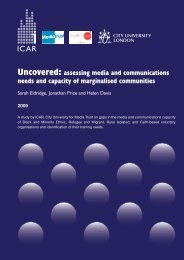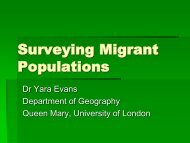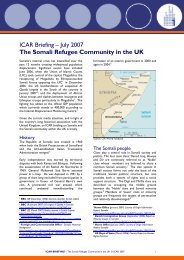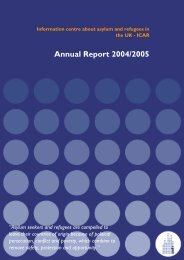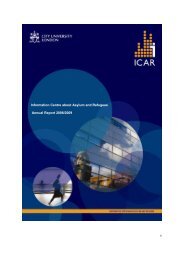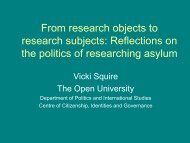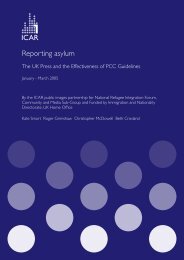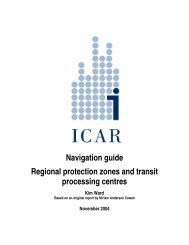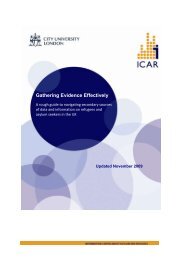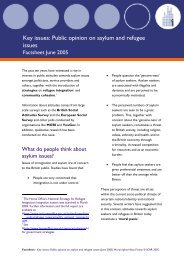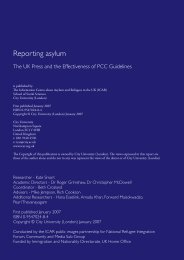The Somali community in the UK: What we know and how we ... - ICAR
The Somali community in the UK: What we know and how we ... - ICAR
The Somali community in the UK: What we know and how we ... - ICAR
You also want an ePaper? Increase the reach of your titles
YUMPU automatically turns print PDFs into web optimized ePapers that Google loves.
esponse to this charge is that <strong>the</strong> <strong>Somali</strong><br />
<strong>community</strong> keeps very much to itself; that it is not<br />
<strong>in</strong>terested <strong>in</strong> ‘<strong>in</strong>tegrat<strong>in</strong>g’ or participat<strong>in</strong>g <strong>in</strong> civil<br />
society. It is true that <strong>the</strong> first generation of <strong>Somali</strong><br />
seamen always set <strong>the</strong>ir sights on return to <strong>Somali</strong>a.<br />
<strong>The</strong>y had not envisaged that events at home would<br />
frustrate <strong>the</strong>ir dreams. This voluntary isolation has<br />
contributed to <strong>the</strong> character of <strong>the</strong> <strong>community</strong>,<br />
with its strong sense of family <strong>and</strong> a common<br />
Muslim identity. <strong>The</strong> high rate of unemployment,<br />
coupled with problems of language, has also<br />
precluded a common route <strong>in</strong>to <strong>the</strong> wider society.<br />
But times have changed, <strong>and</strong> younger generations,<br />
both those escap<strong>in</strong>g violence at home <strong>and</strong> those<br />
born here, have a different relationship to <strong>the</strong> <strong>UK</strong>.<br />
Although often represented <strong>in</strong> policy documents<br />
as undifferentiated, <strong>Somali</strong>s do not form a s<strong>in</strong>gle<br />
group def<strong>in</strong>ed by <strong>the</strong>ir predicaments. To beg<strong>in</strong><br />
with, <strong>the</strong>re is <strong>the</strong> vexed question of <strong>the</strong> term<br />
‘<strong>community</strong>’ - imply<strong>in</strong>g cohesion, uniformity, <strong>and</strong> a<br />
common consciousness. In a certa<strong>in</strong> context its use<br />
is justifiable - not only do <strong>the</strong> majority of <strong>Somali</strong>s<br />
have a common language <strong>and</strong> all share an Islamic<br />
faith, but <strong>the</strong> problems <strong>the</strong>y encounter as refugees,<br />
explored below, are widely shared despite diverse<br />
social characteristics. But if, <strong>in</strong> this report as <strong>in</strong><br />
o<strong>the</strong>rs, this problematic term is used as convenient<br />
shorth<strong>and</strong>, it must not obscure <strong>the</strong> fact that no<br />
ethnic m<strong>in</strong>ority - any more than a native population<br />
- is homogenous. <strong>The</strong> basic divisions are those<br />
<strong>in</strong> any <strong>community</strong>, although <strong>the</strong>y will carry <strong>the</strong>ir<br />
own cultural load. Despite present unemployment<br />
among <strong>Somali</strong>s, <strong>and</strong> <strong>the</strong> popular perception of<br />
refugees as impoverished economic migrants,<br />
many <strong>Somali</strong>s come from <strong>the</strong> educated middle<br />
class who could afford to flee. 7 <strong>Somali</strong> class is a<br />
fluid concept - households both <strong>in</strong> <strong>Somali</strong>a <strong>and</strong> <strong>the</strong><br />
<strong>UK</strong> often conta<strong>in</strong> uneducated members alongside<br />
professionals who share much of <strong>the</strong> same lifestyle.<br />
Never<strong>the</strong>less, <strong>the</strong> experience of a functionally<br />
illiterate old seafarer or a recently arrived youth<br />
with no education is not identical to that of a<br />
university graduate. <strong>The</strong> implications of gender <strong>and</strong><br />
<strong>the</strong> development of men’s <strong>and</strong> women’s roles are<br />
explored below, as is generation, which comb<strong>in</strong>es<br />
5. Information on Liverpool is taken from sources <strong>in</strong> footnotes 10 <strong>and</strong><br />
11 <strong>and</strong> from <strong>in</strong>terviews with <strong>the</strong> Community Resource Unit of Liverpool<br />
City Council; <strong>the</strong> Lodge Lane <strong>Somali</strong> Women’s Group; <strong>the</strong> Liverpool Asylum<br />
Seeker <strong>and</strong> Refugee Partnership, <strong>and</strong> <strong>the</strong> Merseyside Community Centre.<br />
<strong>in</strong> different patterns with <strong>the</strong> age of entry <strong>in</strong>to <strong>the</strong><br />
<strong>UK</strong>. <strong>The</strong> older settler communities, <strong>the</strong> refugees<br />
from <strong>the</strong> civil war of <strong>the</strong> late 1980s <strong>and</strong> 1990s, <strong>and</strong><br />
<strong>the</strong> most recent arrivals via third countries, all have<br />
particular experiences of both <strong>Somali</strong>a <strong>and</strong> <strong>the</strong> <strong>UK</strong>.<br />
Some <strong>Somali</strong>s arrive as adults or elders, some are<br />
born <strong>in</strong> <strong>the</strong> <strong>UK</strong>. Generation <strong>and</strong> birthplace affect<br />
both <strong>the</strong> orientation towards <strong>the</strong> homel<strong>and</strong>, <strong>and</strong><br />
life <strong>in</strong> <strong>the</strong> diaspora.<br />
Area of orig<strong>in</strong> <strong>in</strong> <strong>Somali</strong>a is ano<strong>the</strong>r key variable.<br />
A refugee from nor<strong>the</strong>rn <strong>Somali</strong>l<strong>and</strong> will have had a<br />
different background <strong>and</strong> history from one escap<strong>in</strong>g<br />
from <strong>the</strong> south. This comb<strong>in</strong>es with <strong>the</strong> factor of<br />
clan affiliation, a form of social identification highly<br />
significant <strong>in</strong> <strong>Somali</strong>a <strong>and</strong> with resonance <strong>in</strong> <strong>the</strong><br />
<strong>UK</strong> (see below p. 78). Area of residence <strong>in</strong> <strong>the</strong><br />
<strong>UK</strong> also impacts on <strong>the</strong> refugee experience. <strong>The</strong><br />
density of <strong>the</strong> <strong>Somali</strong> presence, <strong>the</strong> character of <strong>the</strong><br />
neighbourhood, <strong>the</strong> history of <strong>the</strong> <strong>community</strong>, <strong>and</strong><br />
<strong>the</strong> availability of services differ bet<strong>we</strong>en London<br />
boroughs as <strong>we</strong>ll as bet<strong>we</strong>en British cities. F<strong>in</strong>d<strong>in</strong>gs<br />
from To<strong>we</strong>r Hamlets may not be applicable to <strong>the</strong><br />
ne<strong>we</strong>r communities of Harlesden. <strong>Somali</strong>s may<br />
also have different immigration statuses which<br />
<strong>in</strong> turn affect <strong>the</strong>ir relationship to state benefits<br />
<strong>and</strong> employment. Asylum seekers await<strong>in</strong>g <strong>the</strong><br />
outcome of appeals, or those unsure whe<strong>the</strong>r <strong>the</strong>ir<br />
limited leave to rema<strong>in</strong> will be extended, live <strong>in</strong> a<br />
greater state of <strong>in</strong>security than those confirmed as<br />
refugees.<br />
And <strong>the</strong>n <strong>the</strong>re is <strong>the</strong> <strong>in</strong>dividual experience of<br />
war. Unless very young, few <strong>Somali</strong>s <strong>in</strong> <strong>the</strong> <strong>UK</strong><br />
have escaped <strong>the</strong> horrors of armed anarchy, <strong>the</strong><br />
repercussions of a collaps<strong>in</strong>g civil society, or <strong>the</strong><br />
grief of bereavement <strong>and</strong> family separation. But<br />
personal stories differ <strong>and</strong> particular traumas are<br />
carried to <strong>the</strong> <strong>UK</strong>, affect<strong>in</strong>g experience of exile. In<br />
a condensed overview of <strong>Somali</strong>s <strong>in</strong> <strong>the</strong> <strong>UK</strong>, <strong>the</strong>se<br />
nuances may become buried under an essentialised<br />
representation of <strong>the</strong> <strong>community</strong>. But it must be<br />
borne <strong>in</strong> m<strong>in</strong>d that history, personal <strong>and</strong> collective,<br />
determ<strong>in</strong>es both identification <strong>and</strong> difference for<br />
<strong>Somali</strong>s <strong>in</strong> <strong>the</strong> diaspora.<br />
6. Cf. Stokes, 2000: para. 14.4.<br />
7. Farah (2000) provides an <strong>in</strong>terest<strong>in</strong>g <strong>in</strong>sight <strong>in</strong>to <strong>the</strong> different exit<br />
strategies of various sections of <strong>the</strong> middle class, <strong>and</strong> <strong>the</strong> comparative<br />
experience of <strong>the</strong> less fortunate.<br />
<strong>The</strong> <strong>Somali</strong> <strong>community</strong> <strong>in</strong> <strong>the</strong> <strong>UK</strong><br />
7





